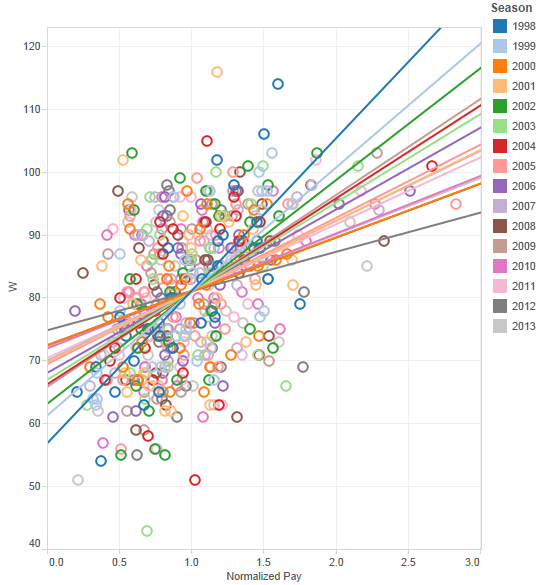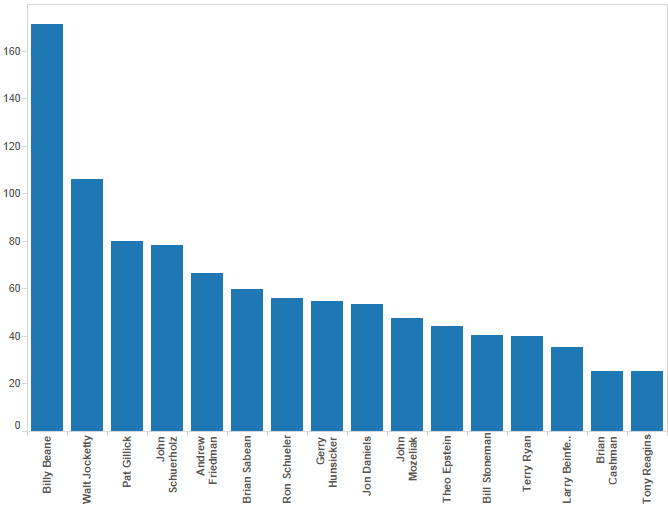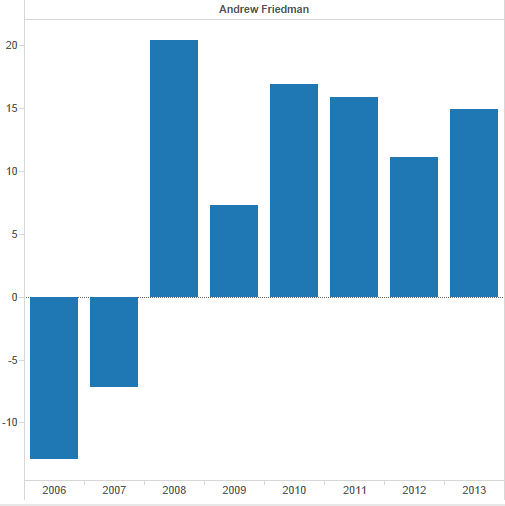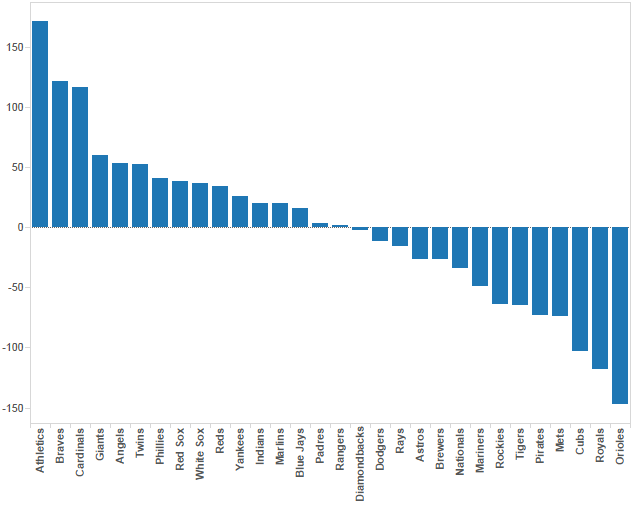Baseball’s Biggest Market Inefficiency
A couple years ago, The Oakland Athletics extended the contract for general manager Billy Beane for an additional 5 years, securing him through the 2019 season. They did not release the specific details of the contract, but we can guess that it’s comparable to the $3-4m that Brian Cashman and Theo Epstein make per year. The A’s are paying Alberto Callaspo $4.1m this year. Neither Beane’s nor Callaspo’s salary is particularly surprising, since both roughly reflect the current market for a top-tier GM and a 30-year-old infielder with a career .273/.335/.381 slash line. But is this reasonable? Should the owner of a baseball team be more willing to pay a mediocre infielder than an elite general manager? If the following data on front office success is any indication, absolutely not.
Using payroll data that goes back to 1998, I wanted to compare how well teams achieved success relative to the budgets they were given by their owner. In order to do so, I ran a regression model for every season to determine what sort of an effect payroll had on wins. For each season, the league average payroll is normalized to “1” to allow every season to be in this chart. As the graph shows, teams with more money tend to win more. If you’re adventurous and feel like interacting with the data you see below, click here and mouse over everything until you pass out.

It’s no surprise that money leads to success, and the fact that certain GMs tend to outperform their budget shouldn’t stun you either. But the extent to which some general managers are better than others is enormous. There are plenty of GMs who did exactly what you’d expect given their budgets. In 9 seasons with the Expos and Mets, Oscar Minaya was given the funds to win 742 games. He won 739. Mark Shapiro was supposed to win 703. He won 704.
Some general managers have better reputations, though. Theo Epstein, former Red Sox GM and current Cubs President of Baseball Operations, was given the budgets that would have resulted in 795 wins from an average GM, but he turned that into 839 wins in Boston. Legendary Braves GM John Schuerholz led a Braves squad that won 78 more games than expected since 1998, when the data begins. The 2nd best on the list, ex-Cardinals and current Reds GM, Walt Jocketty, has been worth an astounding 106 wins.
Then there’s Billy Beane: the Billy Beane who the A’s are paying slightly less than Alberto Callaspo. Under his direction, the Oakland Athletics have won 171 more games than expected. Babe Ruth had a career WAR of 168. Ruth’s best season was worth an absurd 15.0 wins in terms of WAR. Billy Beane has had 6 seasons during which the A’s won 15+ more games than they should have. They’ve never had the money to win 50% of their games, but half their seasons have ended with 20 more wins than losses.
I could go on. But first, let’s look at some visuals.

Here are the 16 general managers whose teams have exceeded their financial expectations by over 25 wins since 1998. If you want to look at every general manager’s wins and expected wins, explore this. One name I have not mentioned so far that has had an impressive stint as head of the Rays is Andrew Friedman. Since he’s been the GM of the Rays, they have been tied with St. Louis as the most cost effective winners in baseball. It’s even more impressive when you consider the dumpster fire he inherited.

After ignoring the potential for mediocrity during his first two seasons and building for the future, Friedman’s Rays took off. In the past 6 years, the Rays have won 87 more games than they should have. While it’s not as good as Beane’s best 6-year stretch of 117, it has coincided with a relatively weak stretch for the A’s where they have only exceeded their budget-wins by 30 games.
Unfortunately, not every team can have a Billy Beane or an Andrew Friedman. Some teams, like my Royals, have had more struggles. This chart, as much as anything else, shows the overwhelming need for effective front office management.

The A’s have been 300 wins more effective than the Orioles the last 16 years. If a win is worth $5m as recent free agency has suggested, then I don’t even want to type how much Billy Beane is worth. If you’re like me, it’s worth your time to explore this chart which shows yearly expectations and results for each team. A couple teams to look for, in addition to the ones I’ve talked about: the Cardinals and Braves have been unsurprisingly excellent, and the Cubs, Royals, and Orioles are worth looking at for less exciting reasons.
So how much should teams be paying their GMs? At this point, that’s an easy answer. $1 more than everyone else will pay, because they are tremendously undervalued right now. After that, the answer isn’t as clear, but I don’t see why they wouldn’t be similarly paid to players. One easy counter argument would be that if you pay the GM too much, he can’t do his job as well because he would have less money with which to pay players. But I think there is sufficient evidence that, for example, the Blue Jays would win more games with the team that Andrew Friedman could assemble with a $97m payroll than their current $117m team. The fact that the Rays will pay $57m this year for their squad should support that claim more than enough.
The free agent market would say that an elite GM could be worth $50-$100m a year. While that might strike people as unreasonable, it’s probably closer to their real value than the replacement level infielder-pay they are receiving now.
I really like this post, but remember that one year of Theo Epstein was traded for the bad Chris Carpenter. Mop-up pitcher extraordinaire. It’s a shame we don’t see marquee GMs traded more often, but I get the feeling that there are a lot of smart people out there that know baseball, exploiting the market, and running a franchise. If Billy Beane quit his job tomorrow and started selling insurance, I bet they’d find a protege to do a similar job.
If you think that there are easily-identified proteges who could do a similar job to Beane, then why do you think that he has been so much better at W/$ than every other GM? Don’t you think that the other 29 teams want to identify the proteges who could do a similar job?
His point was that the A’s have an organization in place that contributes massively to the good decision-making, and the removal of any cog, even GM, would not stop the machine. A protege going to another team without that organizational support in place would not fare as well, under this theory. I have no idea if it’s true, but it’s an opinion not invalidated by your point.
The counterpoint is that Beane built the A’s organizational machine and could do the same thing for another franchise. He would likely do it even faster next time by poaching talent from his previous organization. For example, see what Luhnow is doing in Houston.
*Omar Minaya
Whoops. You are not incorrect.
How do you account for General Managers who have taken over losing situations and large terrible contracts from a previous GM (Sandy Alderson taking over for Omar Minaya for example)?
Short answer: I didn’t. I thought that the ways which GM’s could be affected by their predecessors were too varied to attempt to measure them individually. It certainly affects the some scores of specific GM’s.
But I didn’t think it was entirely relevant to my central thesis. This article intends to mainly prove simply the fact that some GM’s are a lot better than others, and therefore many of them should be getting offered significantly more money. In fact, the effect you mention is even further proof of this, as GM’s can have a lasting impact.
Can you normalize further for opportunity? Seems like the marginal ‘effort’ increases as payroll increases, particularly given the volatility of performance and chance injury.
Obviously, Beane and Friedman have a greater chance of producing excess wins because their spot in the revenue curve would presume they win far fewer games. At some point (116-120?) the maximum number of wins flatlines. Cashman seems like he’d be at a disadvantage trying to go from 95 to 105 because a prospect paid league minimum paid has less opportunity to break the roster – amongst other things.
This is awesome work. My favorite community post in at least a year. Thanks for doing it.
That’s an interesting thought. Since you said that, I went and did the regression models again, but this time to allow the line to be based on a polynomial of 2 degrees. I did this to see if there were diminishing returns. Exactly half of the seasons curved up, and half curved down. If my understanding of this is correct, this should mean there probably wasn’t much of an effect from diminishing returns, and Cashman would have still been given the ability to have similar success compared to Beane with my model.
That said, your argument makes good intuitive sense, so that makes me think there is a good chance it’s correct.
This is amazing work, but it’s too strong to sugggest that it “proves” anything about GM’s. It provides great evidence, but there are too many factors that are impossible to take into account. When we project how a batter will hit next year, we’re commonly basing it on 500-700 plate appearances per year over multiple previous years. But wins and losses are vastly more complex than at-bats, and we have drastically fewer samples.
A few quick examples of variables that cannot be controlled:
– Quality of the scouting system, trainers & resources when the GM arrives.
– The owner’s influence (or lack thereof) on the GM’s decisions.
– Whether it’s a city players like to play in, or free agents prefer to come to.
– Freak injuries to star players.
– Whether one team selects a lousy player in the draft, and the next one picks a future star, but both actually had the same preference (i.e., you can’t assume better process based on better results, when there are so few results to consider).
It is nonetheless really cool data & analysis.
Very fair points, particularly owner involvement. That said, I think the overall sample size on all the data is sufficient even with the complaints you made (all of which I think are valid). The numbers on some of the teams and GM’s are so large that it makes me very confident that the front office team is the most important factor.
Thanks for the praise.
Good work, but it seems like you’re comparing GM WAA with player WAR. In other words, you’re selling the GMs short.
I would love to see this done with Wins Above Replacement GM
Just out of curiosity, what do you think a replacement GM is? I did it against average, obviously. We know a replacement player is worse than average. But if a team is forced to replace an average GM, do we assume it’s a downgrade? I don’t know a super easy way to go about finding out.
Why would the payroll vs. wins curve be modeled as linear?
Because the relationship is pretty linear. As I said in my response to the esteemed BrentDaily, when I made it a polynomial relationship, half the years were concave and half were convex. With no consist polynomial relationship, linear seems to be the most accurate measure.
Would you mind posting your raw data (wins and payroll)?
I don’t know how to upload the spreadsheet onto here, but if you go where I linked that regression lines chart, you can see most of the data. Click the link, then click anywhere on the graph, and then click the export arrow directly underneath the chart and choose “Data.” It shows the normalized pay and wins. Other than that, I’m not sure how to get an excel sheet (which has other variables like raw payroll) on here at this point.
Thanks for the analysis. Very interesting. The GM qualification process must be one of the least efficient meritocracies in the US. Its weaknesses are especially stark against the process of qualifying players which I’d argue is one of the most effective. Applies to all professional sports, I think.
Excellent observation. Much less accountability.
Awesome article. Couple thoughts:
1) Luck always contributes, not sure how much. Has to be accounted for. There is too much out of a GM’s control.
2) Drafting well matters. How do we weigh good drafting versus pick number? Neil Huntington looks great now, but had years of top 4 picks.
3) Payroll doesn’t include int’l signings. In previous years, unlimited int’l signing budgets have been a huge advantage for higher budget teams. Same situation with draft bonuses, though that’s also controlled now.
4) There is an enormous gap in profit between winning 90 games and winning 90 games and the World Series. How is that measured?
5) No one person gets total credit for a win. Pitching coaches don’t get credit for every strikeout, hitting coaches don’t get credit for every home run, etc. How do we find the GM’s unique contribution to wins above expectation?
1. I agree, but the sample sizes on these are usually pretty large, particularly the cases I talked about most.
2. That could certainly be an issue someone, including me, could write a follow-up article on. Since they are intended to be equalizers, though, I didn’t feel bad leaving them out (since Billy Beane tends to have low draft picks, he would seem even more valuable if I counted them.
3. Good point. I would be curious to see how high some of those numbers are. Aside from the Daisukes, Yus, and Tanakas, I would assume they wouldn’t be too high, but still worth looking into.
4. I’m not sure I understand. Are you saying the latter should be considered better because the GM creates revenue and success, or that the GM in the first scenario should be considered unlucky?
5. I’m a believer that the GM should be considered responsible for everything under him. He is in charge of making all the hires. This can be false when the owner gets too involved.
Want to start this by saying again I love the article and mostly agree with the conclusion.
4. I mean that front office personnel have a responsibility to turn a profit. Wins are the way to do that. But winning a WS has been shown to provide a massive bump in profits. An owner/president/ceo should not just look at regular season wins when paying a GM.
5. This sort of goes with my first and second points. Tony Reagins drafted Mike Trout 25th overall. Does he really deserve all the credit? Would he be a less valuable GM if Trout had been picked 24th? If, say, Brian Cashman and his team had Trout ranked at the top of their board but didn’t get a chance to draft him, does Cashman get credit for that? And hires – good hires should be rewarded, but it’s unreasonable to attribute all value to the GM. Every coach/scout/manager has their own value, contributing to wins above expectation. If they get a share of those wins, would it make sense to give the GM full credit for them?
I think those are good points. As far as what you’re saying about the draft picks: I think there could be a cool research topic there, but I’m not remotely good enough to do it myself. Find some relationship between the two variables of “talent remaining” and “average marginal pick,” to see which GM’s tend to out-draft or out-develop those expectations. Hopefully that made sense.
Great article. Like really great.
One quibble: I’d imagine that teams who play in weaker divisions would end up with more wins compared to the actual talent of the team. Wouldn’t it make more sense to adjust this huge factor by using WAR instead of Wins?
For instance, the 2013 Phillies and the 2013 Blue Jays were not equal teams by any stretch of the imagination in terms of talent. However, under your method, they would get approximately equal credit in terms of the wins produced, when in reality they only won a similar number of games because the Phillies played a much easier schedule (and were more lucky).
Just a thought. I’d like to here what you’d think about using WAR instead of Wins.